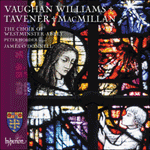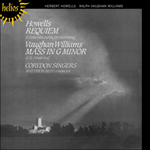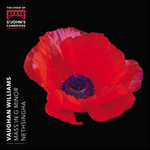
Welcome to Hyperion Records, an independent British classical label devoted to presenting high-quality recordings of music of all styles and from all periods from the twelfth century to the twenty-first.
Hyperion offers both CDs, and downloads in a number of formats. The site is also available in several languages.
Please use the dropdown buttons to set your preferred options, or use the checkbox to accept the defaults.

from notes by Jeremy Dibble © 2023
«On ne voit pas pourquoi un athée ne pourrait pas écrire une belle messe», insistait Vaughan Williams; et Richard Terry, le musicien-liturgiste le plus accompli de sa génération, de se réjouir, assurément comblé par cette nouvelle mise en musique: «Je suis absolument sincère quand je dis que c’est l’œuvre que l’on attendait depuis toujours. Dans votre idiome personnel et moderne, vouz avez véritablement saisi l’esprit et l’atmosphère liturgiques d’antan.»
Cette dualité «idiome moderne»/«esprit liturgique d’antan» est au cœur du succès de cette composition qui prend pour point de départ l’univers sonore du XVIe siècle et son écriture modale, son imitation subtile – un style auquel Vaughan Williams avait déjà recouru dans sa Fantasia on a Theme by Thomas Tallis. Même si elle semble remonter à un monde oublié depuis longtemps, cette Mass n’a rien d’un exercice atavique: c’est une musique nouvelle, colorée par l’amour de Vaughan Williams pour les riches harmonies et dramatisée par la juxtaposition de lignes sinueuses, à la façon grégorienne, et d’une antiphonie chorale étincelante. Ces effets sont obtenus grâce à une écriture très proche de celle de la «Tallis Fantasia» qui avait tant subjugué les amateurs de concerts lors du Three Choirs Festival, dix ans plus tôt, en 1910: deux chœurs à quatre parties SATB (des orchestres à cordes dans la «Fantasia») dialoguent avec un quatuor solo SATB (cordes solo), qui apporte un commentaire plus personnel et passionné.
extrait des notes rédigées par Andrew Carwood © 2005
Français: Hypérion
„Es gibt keinen Grund dafür, warum ein Atheist nicht eine gute Messe schreiben können sollte“ erklärte Vaughan Williams und Richard Terry, der führende Experte seiner Generation in musikalischer Liturgie, war von dem neuen Werk begeistert: „Ich meine es ganz ernst, wenn ich sage, dass dieses Werk von Anfang an auf Sie gewartet hat. Mit Ihrer individuellen und modernen Tonsprache haben Sie den alten liturgischen Geist und die Atmosphäre vollkommen eingefangen.“
Eben diese Dualität der „modernen Tonsprache“ und des „alten liturgischen Geists“ ist der Kern des Erfolgs der Komposition. Ihr Ausgangspunkt ist die Klangwelt des 16. Jahrhunderts mit ihren modalen Harmonien und subtilen Imitationen: ein Stil, dessen Vaughan Williams sich schon in seiner Fantasia on a Theme by Thomas Tallis bedient hatte. Die Messe scheint auf eine längst vergessene Welt zurückzugreifen und ist dabei nicht eine atavistische Übung sondern neue Musik mit den Farben der reichhaltigen Harmonien, die Vaughan Williams so liebte, und einer Dramatik, die sich aus der Gegenüberstellung von gewundenen gregorianischen Stimmen und einer feurigen Chor-Antiphon ergibt. Diese Effekte erzielt er durch eine Besetzung, die der der „Tallis Fantasia“ sehr ähnelt – Letztere hatte das Publikum beim Three Choirs Festival mehr als zehn Jahre zuvor (1910) besonders fasziniert. Zwei vierstimmige Chöre (bzw. Streichorchester in der „Fantasia“) in der Besetzung SATB stehen im Dialog mit einem Solo SATB-Quartett (bzw. Solostreichern), das für einen intimeren, leidenschaftlicheren Kommentar sorgt.
aus dem Begleittext von Andrew Carwood © 2005
Deutsch: Viola Scheffel
 Vaughan Williams, MacMillan & Tavener: Choral works Vaughan Williams, MacMillan & Tavener: Choral worksFrom established favourites by Ralph Vaughan Williams and Sir John Tavener, to recent works—including two premiere recordings—by Sir James MacMillan, this is an outstanding programme of choral works with strong musical and historical connections t ...» More |
 Howells: Requiem; Vaughan Williams: Mass in G minor Howells: Requiem; Vaughan Williams: Mass in G minor‘A moving and impressive addition to the a cappella repertoire’ (The Daily Telegraph) ‘The Corydon Singers are superb in this music … truly exquisite and subtle; this is wonderful choral singing in every way’ (American Record Guide)» More |
 Vaughan Williams: Mass in G minor & other choral works Vaughan Williams: Mass in G minor & other choral worksAndrew Nethsingha and St John's College Choir Cambridge mark the centenary of the 1918 Armistice with a new recording of choral works by Ralph Vaughan Williams.» More |

